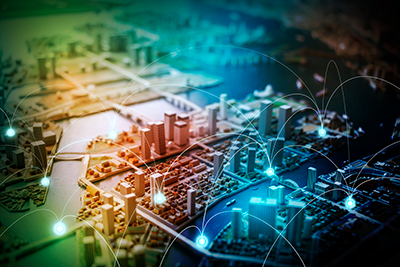
Technology is improving at a more rapid rate than ever before, and we’re at the point now where existing and new technology are coming together to create new and exciting advancements. Computer vision is one such advancement, and it’s being used to create what is being referred to as “smart cities.” Below, we’re going over what computer vision and smart cities are, as well as some of the more exciting aspects of how they can be used together.
What is Computer Vision?
Computer vision is essentially what it sounds like: using computers as our eyes and ears to monitor and make decisions for us. It’s a combination of advanced cameras and other technology used to monitor different aspects of the real world. The information is then parsed by robust algorithms that mimic human interpretation and can be used to make informed decisions based on the application of the computer vision.
What is a Smart City?
Computer vision is cutting edge technology, but it becomes especially impressive when applied to real-world applications, like in the case of a smart city. "Smart city" is a fairly generic term used to describe a city that utilizes updated technology to run smoothly. However, as computer vision advances, the term "smart city" is coming to be used for cities that specifically use computer vision technology to monitor various things and connect people and places within the city with real-time data and information.
How Computer Vision Will be Used in Smart Cities
Computer vision can be used in a myriad of ways, and new applications are being continuously developed. Some of the most recent and impactful uses are in transportation and law enforcement.
Transportation
Cameras connected to street lamps and traffic signals can be used to monitor traffic flow and movement of pedestrians. This data can be interpreted using complex algorithms to determine the most efficient traffic signal patterns in real-time. The result is an optimization of the flow of traffic and the reduction of congestion. These same monitoring devices can also be used to determine the presence of cars and pedestrians. If none are detected, street lights can be dimmed to save electricity, and they can be turned back on for safety after movement is detected. These devices and algorithms are currently being used in some cities to determine if and where parking spaces are available, ultimately making parking significantly easier for drivers in large cities where spots can be limited.
Law Enforcement
Computer vision technology can be used by law enforcement to monitor activity on streets and determine where issues, altercations, or accidents may be taking place. The algorithms used can significantly decrease the amount of monitoring performed by humans that needs to be done and decrease the response time of first responders. The systems are also capable of monitoring areas that are covered by trees or vegetation and aren’t visible by satellite or helicopter, thereby increasing surveillance capability. Additionally, they can identify and report areas of possible illegal construction. It's clear that computer vision is making "smart cities" come to life. It allows for unprecedented advancements in traffic monitoring, ease of navigating cities in real-time, energy-saving measures, and law enforcement surveillance. Whether you're still planning, or ready to implement computer vision technology in your project, start by selecting one of our machine vision cameras. A member of our team can assist you in selecting the right camera based on your unique goals and requirements.
